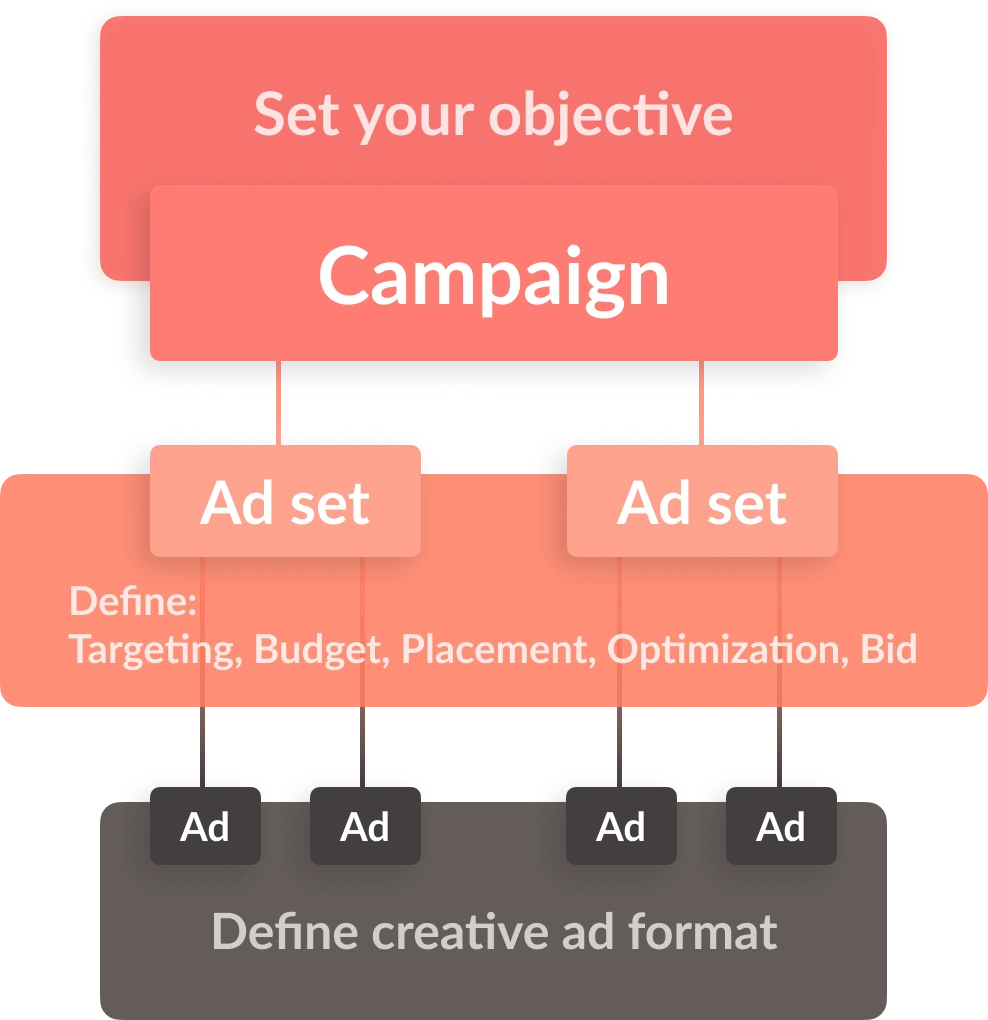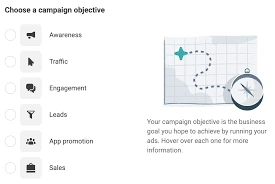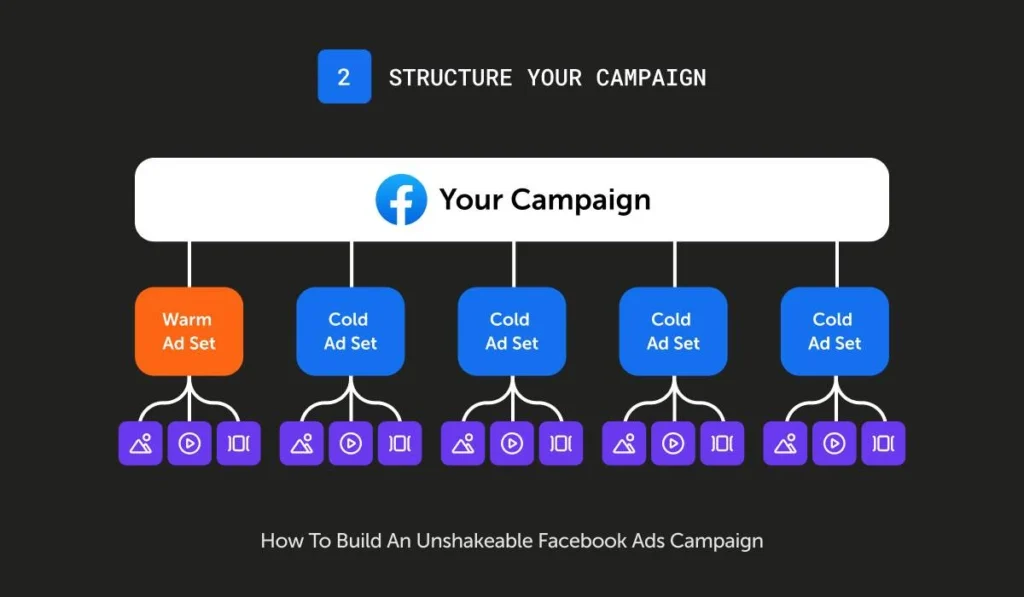
Meta platforms — namely Facebook and Instagram — are among the essential tools of digital marketing. Running ads on these platforms is not just about creating visuals. True success requires proper structure, audience segmentation, and a goal-oriented advertising strategy. This blog will cover both the technical structure of Meta ads and how to effectively target audiences by dividing them into cold, warm, and ready-to-buy stages.
General Structure of Meta Ads
In Meta Ads Manager, an ad campaign consists of three main levels: Campaign, Ad Set, and Ad. Each level has its own function and must be configured correctly.

1. Campaign Level
This stage determines the strategic objective of the ad — in other words, what result you expect from it. Meta offers the following objectives:
- Awareness – Brand recognition and reaching more people
- Traffic – Promoting actions like website visits, video views, and form submissions
- Engagement – Post interactions, app installs, store visits
- Leads – Collecting customer information
- App Promotion – Promoting and increasing mobile app downloads
- Sales (Conversions) – Ads focused on selling a product or service

At this level, you can also activate Campaign Budget Optimization (CBO), which allows Meta’s algorithm to automatically distribute your budget between ad sets — prioritizing the groups that perform better.
2. Ad Set Level
Here you define who, where, and when will see your ad. This level is more tactical, focusing on parameters such as:
- Audience selection: Age, gender, location, interests, behaviors
- Placement: Facebook News Feed, Instagram Stories, Reels, Marketplace, etc.
- Budget and scheduling: Daily or total budget, start and end dates
- Custom Audience and Lookalike Audience: Based on existing customer base or website visitors
- Retargeting lists: Showing ads again to people who have interacted with you before

If the ad set level is poorly structured, even the most creative ads may fail to deliver results.
3. Ad Level
This is the stage where the ad’s visual and text elements are created. The main goal is to grab the audience’s attention, clearly deliver the message, and prompt them to take action.
- Visual formats: Image, video, carousel (slide format)
- Text elements: Headline, main ad text, CTA (Call-to-Action) buttons – such as “Buy now”, “Learn more”
- Link and tracking parameters: Product URLs, UTM tags, Pixel tracking codes
- Creative A/B testing: Testing different visuals or texts of the same ad and comparing performance
What to Do for Cold–Warm Audiences?
One of the main requirements for high performance in Meta ads is segmenting the audience based on behavioral stages. At OnDigital, our approach allows us to deliver the right message to users at the right time. There are three main audience groups: Cold, Warm, and Hot (Ready to Buy).

1. Cold Audience
This group includes people who have never encountered your brand. The goal is to attract their attention for the first time and spark interest in your brand.
Targeting methods:
- Interest-based selections (e.g., fashion, travel, parenting)
- Behavioral filters (e.g., online shoppers, frequent travelers)
- Lookalike audiences – new users similar to your current customers
Recommended ad formats:
- Short and emotional videos
- Promotional visuals
- Content delivered via Instagram and Facebook Stories
For this audience, visuals must be eye-catching and the message must be emotional and simple. The goal is not sales, but to create the first contact and make the brand familiar.
2. Warm Audience
These are users who have already interacted with you but haven’t purchased yet. They know you but haven’t decided to convert.
Targeting methods:
- People who visited your website in the last 30–60 days
- Users who liked, commented, or viewed your social media posts
- People who watched at least 25% of your video ads
Recommended ad formats:
- Carousel ads – to visually present multiple products
- Testimonial videos – real customer reviews
- Short, explanatory videos and images showing product usage
At this stage, the goal is to deepen interest and provide reasons to make a decision. It’s not just about brand awareness but proving the value you offer.
3. Hot Audience (Ready to Buy)
This audience is at the bottom of the sales funnel. These are people who added a product to the cart but didn’t complete the purchase, left at the checkout page, or have bought from you before. The goal is to speed up their decision and complete the conversion.
Targeting methods:
- Users who added to cart but didn’t purchase
- Users who abandoned the checkout page
- Existing customer list – created using email and phone numbers
Recommended ad formats:
- CTA-heavy ads offering discounts and coupons
- “You left something in your cart” reminder visuals
- Short-term campaigns and limited-time offers
The message delivered to this audience must encourage urgent decision-making. Less promotion, more sales-driven calls to action are key.
Aligning Structure and Strategy with Audience
The ad structure is not just a technical layout — it’s the visual form of your strategy. Each level serves a specific purpose and must be aligned with the audience stage.
| Stage | Campaign Objective | Ad Format | Audience |
| Awareness | Brand Awareness | Video, Reach | Cold Audience |
| Consideration | Traffic, Engagement | Carousel, Lead Form | Warm Audience |
| Conversion | Sales, Conversions | CTA-heavy, Offers | Hot Audience |
Tips for a Successful Meta Advertising Strategy
- Segment your audience in advance
- Choose the right campaign objective for each stage
- Set up Pixel and Conversion Events properly
- Plan the strategy in the “cold → warm → hot” sequence
- Use A/B testing to consistently analyze performance
- Always leverage retargeting and lookalike features
Meta advertising requires not just technical knowledge, but also precise planning and strategic thinking. By building campaigns with a thought-out structure from start to finish, you’ll boost both brand awareness and conversion performance.
Simply running ads is not enough to succeed with Meta. The right plan, the right audience, and the right content are essential. At OnDigital, we manage this entire process professionally to promote your brand effectively with our Digital Marketing services.



